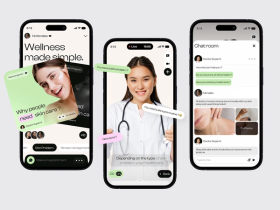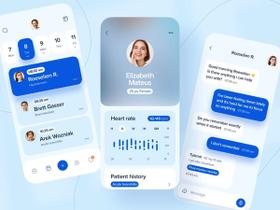Key Takeaways:
- Healthcare kiosk software is more than just a user interface; it is a secure digital solution that connects patients, administrative systems, and healthcare providers into one efficient workflow.
- New kiosk systems are based on React or Flutter frontends, Node.js/.NET backends, and FHIR-compatible APIs that connect to EHRs, insurance systems, and payment gateways.
- Custom kiosks cut administrative costs in half.
- Custom solutions are more flexible and tailored to each clinic's workflow, can be easily integrated with internal systems, and scaled across multiple locations.
- With experience in healthcare, IoT, and HIPAA-compliant software, Stormotion develops scalable kiosk platforms with secure architecture and user-friendly design.
Digital transformation in healthcare is not just about mobile apps or EHR systems – it's also what you see at the hospital entrance and what starts your comfortable visit to the doctor.
Healthcare kiosk software allows patients to check in for appointments or queue up, update their records, and make payments using easy-to-use self-service kiosks, which improves workflow efficiency and frees up clinical staff to better serve patients.
In this article, we'll talk about the development of healthcare kiosk systems, where they are used, their main functions, and how such kiosks are transforming the work of hospitals. Let's get started!
What Is Healthcare Kiosk Software?
Healthcare kiosk software is a digital solution that manages self-service systems in hospitals, clinics, and other healthcare facilities. It allows patients to independently perform typical administrative and clinical functions, such as self-registration, appointment scheduling, payment, and changing personal data or insurance information without the help of staff.
Such systems operate through touchscreen terminals or tablets that are part of the hospital's digital infrastructure. They can connect to EHR systems via FHIR API, integrate with payment gateways, and protect patient access with cards, QR codes, and biometric information, depending on the configuration.

Kiosk software developed by Stormotion
(image by Stormotion)
Let's take a closer look at the main types of healthcare kiosks:
Types of Healthcare Kiosks
Self-Сheck-In Kiosks | Allow patients to check in for appointments, verify insurance information, sign consent forms, and update medical records. |
Payment Kiosks | Secure and contactless payment for consultations (credit/debit cards, NFC payments), lab tests, or prescriptions. |
Telemedicine Kiosks | Remote consultations via integrated video conferencing, allowing patients to connect with doctors from different departments or remote clinics. |
Orientation and Wayfinding Kiosks | Help patients and visitors navigate large hospitals with interactive maps, QR signs, and digital signage. |
Why Healthcare Providers Invest in Kiosk Solutions
In order for hospitals to serve patients more efficiently without compromising the high quality of medical care, healthcare kiosks come to the rescue. They help medical professionals optimize resources, minimize human error, and ensure a smoother patient care process from arrival to discharge.
Let's take a closer look at how they affect the hospital's workflow:
Reducing Patient Wait Times
Self-service kiosks significantly reduce queues. For example, some healthcare facilities report a 40-70% reduction in wait times when using kiosks for patient registration and queue management.
Optimising Administrative Tasks
Every hospital patient must undergo a certain check and fill out personal information. Healthcare kiosks automate these repetitive processes. For example, a patient can immediately:
- Check their insurance and whether it covers a particular appointment
- Read and sign all necessary documents before the appointment
- Pay for the appointment
- View and update their medical information
As a result, medical staff do not have to deal with so much paperwork and can better focus on the patient and their problem.
Improving Data Accuracy
Manual data entry always carries the risk of inconsistencies and errors, especially during peak hours or emergencies. With healthcare kiosk software connected to hospital information systems and cloud databases, data is automatically verified and synchronized in real time.
Enhancing the Patient Experience
People are accustomed to quality service, whether in a store, bank, or hospital. Kiosks with touch screens, intuitive interfaces, and ease of use can improve service quality. Such kiosks can use multilingual and accessible interfaces that are suitable for different population groups. Or they can display and update the queue sequence and approximate waiting time.

Digital rehabilitation platform developed by Stormotion
(image by Stormotion)
24/7 Accessibility / Extended Hours
Healthcare kiosks can operate outside of medical staff working hours, allowing patients who are late or need urgent care to register, make payments, or update their information on their own.
Better Operational Analytics & Workflow Insights
Healthcare kiosks can collect and analyze data about their use, such as peak hours, typical visits, number of patients, reason for visit, and so on. This data can then be used to optimize hospital processes and resources.
Ready to streamline patient flow and reduce wait times with a custom kiosk system?
Contact Us!
Core Features of a Modern Healthcare Kiosk System
A well-designed healthcare kiosk system goes far beyond a touchscreen interface. It combines user-centric UX, secure back-end integrations, and healthcare-specific compliance standards to ensure safe, efficient, and reliable self-service for both patients and staff.
Below are the key features that define a modern enterprise-grade kiosk solution.
Patient Check-In & Registration
This is the primary feature for most healthcare kiosk systems. Patients can verify their identity (using a QR code, patient ID number, or phone number), confirm or change appointment details, or immediately digitally sign the necessary documents.
Appointment Scheduling & Queue Management
To optimize patient flow, healthcare kiosks combined with EHR system integration allow patients to independently book and reschedule appointments and view approximate wait times and their place in the queue.
Insurance Verification & Payments
Kiosks can verify insurance coverage through API integration with insurance companies. Patients can pay immediately using a card, NFC, or mobile payment systems, and receipts can be printed or sent via SMS/email.
EHR Integration
It is important to have seamless access to electronic health record (EHR) systems. Kiosks can transmit information via HL7 API or FHIR (Fast Healthcare Interoperability Resources) and securely manage patient records, transmit updated demographic or medical information, and explore automated workflows such as physician notifications or laboratory test orders.
This interaction will ensure consistency in data exchange between different healthcare systems, which is the basis for digital interaction in the healthcare industry.
ID Scanning & Data Validation
Healthcare kiosks can have external or built-in peripherals such as cameras, barcode scanners, or document readers. This allows patients to quickly complete the verification and form-filling stages.
Multi-Language & Accessibility Support
Hospitals serve different categories of the population. Modern healthcare kiosk software should have a multilingual interface, the ability to easily switch between languages, and provide accessibility options such as text-to-speech, font enlargement, and contrast (ADA and WCAG standards).
HIPAA Compliance & Data Security
Data security and privacy is a separate topic that deserves to be highlighted. Your healthcare kiosk software must be HIPAA compliant:
- Encryption of data transfers using TLS/SSL.
- Automatic log-in to the system and secure log-out.
- Data cleansing and anonymization of local storage.
- Role-based access control.
Advanced Features
With the advancement of healthcare technology, new kiosk systems allow and even require the use of artificial intelligence, biometrics, and IoT solutions. Among the most promising improvements are:
Biometric Authentication | Face recognition or fingerprint scanning. |
AI-Powered Triage | Predictive AI recommendations and referrals based on patient data analysis (symptoms, medical history). |
Wearable & Device Integration | Bluetooth or Wi-Fi-enabled medical devices (e.g., tonometer, thermometer, glucometer, etc.) can be connected to kiosks to automatically record readings during registration. |
Predictive Analytics | Data from kiosks helps medical staff predict the busiest periods and allocate staff efficiently. |
Technology Stack for Healthcare Kiosk Software Development
The appropriate technology stack determines the effectiveness of a healthcare kiosk in terms of its functionality, scalability, and interaction with hospital systems.
Below are the main technologies that can be used when developing software for healthcare kiosks:
Frontend Technologies
React - for developing dynamic and component-based user interfaces
Angular - for structured enterprise-level applications.
Backend Technologies
Node.js - for event-driven and real-time communication with hospital systems.
.NET - for large healthcare companies with Microsoft-based structures.
Python - for functions related to artificial intelligence or analytics.
💡 Backend solutions must meet high security standards (HIPAA, GDPR) and be designed with APIs in mind to easily integrate with third-party systems.
Databases
PostgreSQL - supports secure transactions with patient records and payments.
MongoDB - can store dynamic patient interactions, kiosk logs, or analytics data.
Hardware Integration Layer
- ID card or barcode scanners to identify patients or verify their insurance cards.
- NFC readers for registration or payment authorization.
- Receipt, wristband, or queue ticket printers.
- Biometric and facial recognition cameras/telemedicine video verification.
At Stormotion, this experience has been leveraged in projects such as STEPR and Milence, where our team deployed complex hardware interfaces with Android-based consoles and payment terminals and ensured synchronization, updates, and stable connections over long distances.
Cloud Infrastructure & APIs
AWS or Microsoft Azure for serverless hosting, encryption, and data processing.
FHIR (Fast Healthcare Interoperability Resources) for standardized communication with EHRs such as Epic, Cerner, or Meditech.
APIs (Stripe, PayPal, clearing houses) for secure, PCI-DSS, and financial transactions.
Need help selecting the right stack or integrating your kiosk software with EHR and payment systems?
Talk to our experts!
Custom Development vs. Off-the-Shelf Solutions
The next step in choosing a healthcare kiosk system is deciding whether to use an off-the-shelf solution or build a custom solution. With both options, you will create a healthcare kiosk, but they differ significantly in scalability, compliance, and long-term flexibility.
Let's take a look at the advantages and disadvantages of these two methods:
Off-the-Shelf Kiosk Solutions
Ready-made kiosks are best suited to easily meet the needs of the global market. They are delivered quickly and have built-in modules for registration, payment, and queue management. Ideal for small clinics or pilot projects.
Advantages | Disadvantages |
|---|---|
|
|
Custom Healthcare Kiosk Software Development
A custom healthcare kiosk system is developed based on the facility's workflow requirements, IT environment, and compliance requirements so that you have complete control. This solution is better suited for large clinics and medical centers.
Advantages | Disadvantages |
|---|---|
|
|
How to Develop Healthcare Kiosk Software Step-by-Step
Writing code and logic for a healthcare kiosk is not all that needs to be done. Developing this type of software requires a structured approach to create a simple, secure, and accessible interface between medical staff and patients.

Our detailed healthcare software development process
(image by Stormotion)
Here's how we typically plan the process and what we focus on at each stage:
Discovery & Requirements Gathering
Any successful healthcare kiosk initiative starts with clarity. We find out who will be using the kiosk, what problems it should solve, and how it can be integrated into the hospital's digital ecosystem.
This stage is aimed at developing a comprehensive product description and system plan that business and technical staff can rely on.
UI/UX Design for the Kiosk Interface
Design influences patients' perception of the hospital's digital journey. The basic principles of healthcare kiosk design, which you can already see in ready-made solutions and which we recommend applying, are:
- Large touch elements and a contrasting color palette for good readability.
- Convenient progress indicators that reduce anxiety during registration or payment.
- Multilingualism and localization of interfaces.
- Implementation of interface accessibility for different segments of the population (text-to-speech conversion or text resizing).
Backend Development & EHR Integration
Authentication, scheduling, billing, and secure data exchange with hospital databases are managed by the kiosk's backend.
At Stormotion, we develop this layer in Node.js, .NET, or Python, based on the client's infrastructure. Our competitive goals include seamless EHR integration, secure payments, effective data security, and expansion to different sites.
Testing & Hardware Synchronization
Testing healthcare kiosks is more than just testing software logic. We must ensure that all components, such as the barcode scanner and NFC reader, are reliable in real-world conditions.
Testing also covers:
- Functional testing of registration, payment, and data synchronization.
- Integration of printer, scanner, and biometric equipment.
- Testing during peak hours to replicate real-world queue conditions.
- HIPAA and security audits, encryption, data processing, and device memory clearing after each session.
Deployment & On-Site Setup
At this stage, you should use remote device update and monitoring features. Establish a secure network connection to the EHR. Check the equipment on site. Launch a pilot project to get feedback from real users.
Maintenance & Continuous Improvement
Focus on continuous monitoring and improvement after launch. Monitor performance in real time, install updates remotely, verify security and HIPAA compliance, and analyze user feedback to optimize the experience.
Let’s turn your concept into a secure, HIPAA-compliant kiosk solution.
Start your project with Stormotion!
Use Cases and Real-World Applications
In this section, we will look at typical examples of medical kiosk applications:
Hospitals & Clinics
Kiosks provide a simple way to check in, make appointments, and pay at hospitals and clinics. They help patients save time in long queues and reduce paperwork for medical staff.
📚 Case study: AdventHealth in the US has self-check-in kiosks that allow patients to check in individually in a matter of minutes.
Laboratories & Diagnostics
Kiosks are used in diagnostic centers to check samples, print barcode labels, and accept payments, reducing paperwork and data entry errors.
📚 Case study: Quest Diagnostics has implemented a self-service kiosk with an online appointment scheduling system that allows patients to make appointments, book test orders, and print sample labels upon arrival.
Pharmacies
Kiosks are used in pharmacies to check prescriptions, dispense medications, and accept payments.
📚 Case study: Walgreen has equipped some of its stores in the US with pharmacy kiosks where customers can drop off or pick up prescriptions.
Urgent Care & Vaccination Stations: High-Volume Automation
Healthcare kiosks play an important role in quick registration, consent form completion, and queue management during vaccination or medical crisis situations.
📚 Case study: CVS Health used self-service kiosks for appointment scheduling, insurance verification, and digital consent during its COVID-19 vaccination campaign.
Benefits of Custom Healthcare Kiosk Software
Let's talk in more detail about custom solutions for kiosks in the healthcare sector. Making a decision to develop custom software is quite difficult, because your money, time, and reputation are at stake.
Here are the main benefits of developing a custom solution for healthcare kiosks:
Reduced Operational Costs
Patient registration, payment processing, and other paperwork take up additional time for administrative staff. A custom kiosk designed to meet your specific needs will eliminate manual work, relieve staff overload, and allow them to focus on other more important tasks (patient care, coordination).
Improved Patient Satisfaction
Custom software allows hospitals to adapt the interface to their brand, tailor workflows to the demographics of their patients, and include features that are not typically available in generic systems.
Faster Onboarding & Accurate Data Entry
Healthcare kiosks sync with electronic medical records, allowing you to quickly pull up all the necessary information about the patient and their condition. The risk of data errors is reduced because it is no longer manual work.
Secure Payment & Insurance Processing
Payments in the healthcare industry must meet high compliance and confidentiality requirements. The built-in kiosk platform is a secure, HIPAA- and PCI-DSS-compliant payment flow integrated into the facility's internal systems.
Scalability for Multi-Clinic Networks
Kiosk platforms are built on a cloud-based, modular architecture that can be deployed in any clinic, lab, or pharmacy to achieve consistent quality and performance.
Why Partner with Stormotion for Healthcare Kiosk Software Development
At Stormotion, we combine our expertise in healthcare, the Internet of Things, and connected devices with modern engineering practices. This allows us to help our partners create kiosk systems that are secure, scalable, and truly applicable in real-world clinical settings.
Here's what sets us apart.
Expertise in Healthcare & IoT Software
We develop software that combines the physical and electronic aspects of healthcare. Our staff has created and manufactured solutions for medical, fitness, and wellness products, such as mobile applications for connected rehabilitation devices and embedded Android systems for smart fitness consoles.
Our experience working on projects such as STEPR (an embedded Android console in fitness equipment) and Milence (an Android app for payment collection and acceptance kiosks) has improved our capabilities in touch interfaces, peripheral device integration, and OTA updates, which are challenges when implementing kiosks in the healthcare field.

STEPR app by Stormotion
(image by Stormotion)
This combination of IoT and UX knowledge allows us to develop kiosk software that is smooth and natural, rather than technical. Our goal is to develop not only a technically sound application, but one that is convenient for patients to use.
Proven Experience with HIPAA-Compliant Apps
Our team has developed health and wellness platforms that comply with HIPAA and GDPR requirements.

Caspar Health app by Stormotion
(Image by Stormotion)
We have examples of Caspar Health and LifeBonus, where we solved the problem of secure data exchange between patients, therapists, and clinicians. The same experience can be directly applied to kiosks that require secure authentication, consent, and connection to EHR.
Agile and Transparent Workflow
Stormotion has an open, flexible, and agile workflow. Over the years, we have developed a so-called Development Code that focuses on building solutions rather than features. We never create functional checklists, but rather develop designs that work with the end workflow and user.
Scalable Solutions for Startups and Enterprises
At Stormotion, we develop solutions with future scalability in mind. From IoT and eMobility platforms to fitness and medical applications, we successfully support our customers in launching scalable digital products that are easy to maintain.

Nosk app by your custom app development partner - Stormotion
(Image by Stormotion)
We always focus on long-term partnerships rather than short-term implementation to ensure that your healthcare kiosk solution evolves alongside your business and technology stack.

![Stormotion client Max Scheidlock, Product Manager from [object Object]](/static/33294af91c38256bcd5a780ddc41861a/b0e74/max.png)



